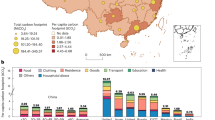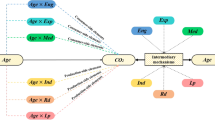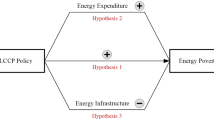Abstract
Population dynamics has been acknowledged as a key concern for projecting future emissions, partly because of the huge uncertainties related to human behaviour. However, the heterogeneous shifts of human behaviour in the process of demographic transition are not well explored when scrutinizing the impacts of population dynamics on carbon emissions. Here, we expand the existing population–economy–environment analytical structure to address the above limitations by representing the trend of demographic transitions to small-family and ageing society. We specifically accommodate for inter- and intra-life-stage variations in time allocation and consumption in the population rather than assuming a representative household, and take a less developed province, Sichuan, in China as the empirical context. Our results show that the demographic shift to small and ageing households will boost energy consumption and carbon emissions, driven by the joint variations in time-use and consumption patterns. Furthermore, biased pictures of changing emissions will emerge if the time effect is disregarded.
This is a preview of subscription content, access via your institution
Access options
Access Nature and 54 other Nature Portfolio journals
Get Nature+, our best-value online-access subscription
9,800 Yen / 30 days
cancel any time
Subscribe to this journal
Receive 12 digital issues and online access to articles
¥14,900 per year
only ¥1,242 per issue
Buy this article
- Purchase on SpringerLink
- Instant access to full article PDF
Prices may be subject to local taxes which are calculated during checkout





Similar content being viewed by others
Change history
17 May 2022
A Correction to this paper has been published: https://doi.org/10.1038/s41560-022-01026-5
References
Harper, S. Economic and social implications of aging societies. Science 346, 587–591 (2014).
Cohen, J. E. Human population: the next half century. Science 302, 1172–1175 (2003).
O’Neill, B. C. et al. Global demographic trends and future carbon emissions. Proc. Natl Acad. Sci. USA 107, 17521–17526 (2010).
Jiang, L. & Hardee, K. How do recent population trends matter to climate change? Popul. Res. Policy Rev. 30, 287–312 (2011).
Allcott, H. & Mullainathan, S. Behavior and energy policy. Science 327, 1204–1205 (2010).
Dietz, T., Gardner, G. T., Gilligan, J., Stern, P. C. & Vandenbergh, M. P. Household actions can provide a behavioral wedge to rapidly reduce US carbon emissions. Proc. Natl Acad. Sci. USA 106, 18452–18456 (2009).
Rosa, E. A. & Dietz, T. Human drivers of national greenhouse-gas emissions. Nat. Clim. Change 2, 581–586 (2012).
Contestabile, M. Social sciences: Broadening energy research. Nat. Clim. Change 4, 420–420 (2014).
Druckman, A., Buck, I., Hayward, B. & Jackson, T. Time, gender and carbon: A study of the carbon implications of British adults’ use of time. Ecol. Econ. 84, 153–163 (2012).
Ellegård, K. & Palm, J. Visualizing energy consumption activities as a tool for making everyday life more sustainable. Appl. Energy 88, 1920–1926 (2011).
Nässén, J. & Larsson, J. Would shorter working time reduce greenhouse gas emissions? An analysis of time use and consumption in Swedish households. Environ. Plann. C 33, 726–745 (2015).
Gørtz, M. Leisure, Household Production, Consumption and Economic Well-Being. PhD thesis, Univ. Copenhagen (2006).
Lee, R. How Population Aging Affects the Macroeconomy. In Econ. Policy Symp. (Federal Reserve Bank of Kansas City, Jackson Hole, 2014); https://www.kansascityfed.org/publicat/sympos/2014/2014Lee.pdf
Menz, T. & Welsch, H. Population aging and carbon emissions in OECD countries: Accounting for life-cycle and cohort effects. Energy Econ. 34, 842–849 (2012).
Becker, G. S. A theory of the allocation of time. Econ. J. 75, 493-517 (1965).
Yang, Y., Zhao, T., Wang, Y. & Shi, Z. Research on impacts of population-related factors on carbon emissions in Beijing from 1984 to 2012. Environ. Impact Assess. Rev. 55, 45–53 (2015).
Fu, C., Wang, W. & Tang, J. Exploring the sensitivity of residential energy consumption in China: Implications from a micro-demographic analysis. Energy Res. Soc. Sci. 2, 1–11 (2014).
Pachauri, S. An analysis of cross-sectional variations in total household energy requirements in India using micro survey data. Energy Policy 32, 1723–1735 (2004).
O’Neill, B. C., Ren, X., Jiang, L. & Dalton, M. The effect of urbanization on energy use in India and China in the iPETS model. Energy Econ. 34, S339–S345 (2012).
O’Neill, B. C., Jiang, L. & Gerland, P. Plausible reductions in future population growth and implications for the environment. Proc. Natl Acad. Sci. USA 112, E506 (2015).
MacKellar, F. L., Lutz, W., Prinz, C. & Goujon, A. Population, households, and CO2 emissions. Popul. Dev. Rev. 21, 849–865 (1995).
Bin, S. & Dowlatabadi, H. Consumer lifestyle approach to US energy use and the related CO2 emissions. Energy Policy 33, 197–208 (2005).
Dalton, M., O’Neill, B., Prskawetz, A., Jiang, L. & Pitkin, J. Population aging and future carbon emissions in the United States. Energy Econ. 30, 642–675 (2008).
Melnikov, N. B., O’Neill, B. C. & Dalton, M. G. Accounting for household heterogeneity in general equilibrium economic growth models. Energy Econ. 34, 1475–1483 (2012).
Davis, S. J. & Caldeira, K. Consumption-based accounting of CO2 emissions. Proc. Natl Acad. Sci. USA 107, 5687–5692 (2010).
Liddle, B. & Lung, S. Age-structure, urbanization, and climate change in developed countries: revisiting STIRPAT for disaggregated population and consumption-related environmental impacts. Popul. Environ. 31, 317–343 (2010).
O’Neill, B. C. & Chen, B. S. Demographic determinants of household energy use in the United States. Popul. Dev. Rev. 28, 53–88 (2002).
Jalas, M. & Juntunen, J. K. Energy intensive lifestyles: Time use, the activity patterns of consumers, and related energy demands in Finland. Ecol. Econ. 113, 51–59 (2015).
Jalas, M. The everyday life context of increasing energy demands. J. Ind. Ecol. 9, 129–145 (2005).
Neuwirth, N. The Determinants of Activities within the Family: A SUR-Approach to Time Use Studies. Working Paper No. 59 (Austrian Institute for Family Studies, 2007)
Wang, D., Chai, Y. & Li, F. Built environment diversities and activity–travel behaviour variations in Beijing, China. J. Transp. Geogr. 19, 1173–1186 (2011).
Lee, R. D. & Mason, A. Population Aging and the Generational Economy: A Global Perspective (Edward Elgar Cheltenham, UK, Northampton, 2011).
National Bureau of Statistics China 2008 China Time Use Survey Data Compilation (China Statistics Press, Beijing, 2009).
Liu, Z. et al. Targeted opportunities to address the climate-trade dilemma in China. Nat. Clim. Change 6, 201–206 (2015).
Gruebler, A. Technology and Global Change (Cambridge Univ. Press, Cambridge, 1998).
World Population Prospects: The 2012 Revision (UN DESA, 2013).
Clayton, S. et al. Psychological research and global climate change. Nat. Clim. Change 5, 640–646 (2015).
Hamza, N. & Gilroy, R. The challenge to UK energy policy: An ageing population perspective on energy saving measures and consumption. Energy Policy 39, 782–789 (2011).
Baral, R., Davis, G. C. & You, W. Consumption time in household production: Implications for the goods-time elasticity of substitution. Econ. Lett. 112, 138–140 (2011).
Brenčič, V. & Young, D. Time-saving innovations, time allocation, and energy use: Evidence from Canadian households. Ecol. Econ. 68, 2859–2867 (2009).
Hamermesh, D. S. Time to eat: household production under increasing income inequality. Am. J. Agric. Econ. 89, 852–863 (2007).
Jalas, M. A time use perspective on the materials intensity of consumption. Ecol. Econ. 41, 109–123 (2002).
Cogoy, M. Dematerialisation, time allocation, and the service economy. Struct. Change Econ. Dynam. 15, 165–181 (2004).
Gomi, K., Shimada, K. & Matsuoka, Y. A low-carbon scenario creation method for a local-scale economy and its application in Kyoto city. Energy Policy 38, 4783–4796 (2010).
Shimada, K., Tanaka, Y., Gomi, K. & Matsuoka, Y. Developing a long-term local society design methodology towards a low-carbon economy: An application to Shiga Prefecture in Japan. Energy Policy 35, 4688–4703 (2007).
Liu, Z. et al. Reduced carbon emission estimates from fossil fuel combustion and cement production in China. Nature 524, 335–338 (2015).
National Bureau of Statistics China China Energy Statistical Yearbook 2010 (China Statistics Press, Beijing, 2010).
Sichuan 12th Five-Year Population Development Plan (The People’s Government of Sichuan Province, 2012); http://www.sc.gov.cn/10462/10883/11066/2012/3/19/10203598.shtml
Zeng, Y., Land, K. C., Gu, D. & Wang, Z. Household and Living Arrangement Projections: The Extended Cohort-Component Method and Applications to the US and China (Springer, 2013).
China to Protect Migrant Workers’ ‘Left-Behind’ Children BBC News Asia (15 February 2016); http://www.bbc.com/news/world-asia-35581716
Fridley D. et al. China Energy and Emissions Paths to 2030 Report No. LBNL-4866E (Ernest Orlando Lawrence Berkeley National Laboratory, 2012); https://china.lbl.gov/sites/all/files/lbl-4866e-rite-modelaugust2012.pdf
China Electric Power Industry Satistics Analysis 2011 (China Electricity Council, 2011)
Zhang, L., Li, H. & Gudmundsson, O. Comparison of district heating systems used in China and Denmark. Euroheat Power (Engl. edn) 10, 12–19 (2013).
Dai, Y. & Hu, X. Potential and Cost Study on China’s Carbon Mitigation Technologies (China Environment Press, Beijing, 2013).
Kainuma, M., Matsuoka, Y. & Morita, T. Climate Policy Assessment: Asia-Pacific Integrated Modeling (Springer Japan, 2011).
SAC/TC20, CECA, CSP. Standards Collection of Energy Consumption per Unit Product (China Standard Press, Beijing, 2014).
National Bureau of Statistics China China Statistical Yearbook 2009 (China Statistics Press, Beijing, 2009).
Acknowledgements
This work was supported by the programme ‘Japan Society for the Promotion of Science (JSPS) Postdoctoral Fellowship for Foreign Researchers’. The authors acknowledge financial support received through China’s National Key R&D Program (2016YFA0602603), and the National Natural Science Foundation of China (no. 71603020, no. 71521002 and no. 71642004). We also acknowledge the support of the National Bureau of Statistics China in sharing the 2008 time-use data with us, and acknowledge the support of the Joint Development Program of Beijing Municipal Commission of Education. We thank B. van Ruijven for his kind help in providing information for the Population–Environment–Technology (PET) model.
Author information
Authors and Affiliations
Contributions
B.Y. designed the research and performed the analysis. Y.M. conceived the paper. Y.-M.W. and K.G. contributed to the methodology improvement and scenario design. All authors contributed to writing the paper.
Corresponding authors
Ethics declarations
Competing interests
The authors declare no competing financial interests.
Additional information
Publisher’s note: Springer Nature remains neutral with regard to jurisdictional claims in published maps and institutional affiliations.
Electronic supplementary material
Supplementary Information
Supplementary Tables 1–5, Supplementary Figures 1–5, Supplementary Note 1 and Supplementary References
Rights and permissions
About this article
Cite this article
Yu, B., Wei, YM., Gomi, K. et al. Future scenarios for energy consumption and carbon emissions due to demographic transitions in Chinese households. Nat Energy 3, 109–118 (2018). https://doi.org/10.1038/s41560-017-0053-4
Received:
Accepted:
Published:
Issue Date:
DOI: https://doi.org/10.1038/s41560-017-0053-4



